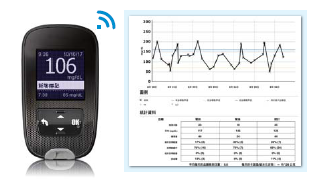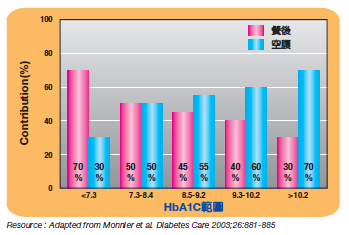【圖文】血糖管理,只看糖化血色素是不夠的 !
See Beyond HbA1C
李氏聯合診所 徐慧君 副主任
王先生是位自我要求很高的人,為了將血糖控制更理想,他採取4次胰島素積極治療方式,多年的糖尿病病史,一直將糖化血色素(HbA1c)控制在6.5%以下,每次回診他都會將工工整整的血糖紀錄本拿給專業人員看,一星期至少會測個10-12次,每個數字都在標準範圍,病友們都以『控糖達人』稱呼他。
王先生是一個喜歡嘗試新事物的人,半年前醫療人員建議他使用血糖管理工具,他很有興趣更希望自己成為達人,因此透過衛教師的協助,他開始使用此管理工具,但也同時揭開他以為糖化血色素控制好就可以的迷思。

透過血糖管理工具,醫療人員發現,王先生實際監測的次數比他在紀錄本上的次數還多,而且他有經常性的半夜低血糖問題,只要半夜血糖低,第二天早上的血糖就會明顯高很多,但是半夜不舒服所監測的血糖值以及第二天早上偏高的血糖值,並沒有抄錄在紀錄本裡;會造成這種情況是因為他習慣睡前吃點水果或餅乾,但又害怕血糖過高,所以會多打速效胰島素;王先生認為半夜血糖低不是大問題,最重要的是將糖化血色素控制6.5%以下才是重點。
糖化血色素控制在標準範圍,就真的都沒事了嗎?
根據2015年出刊的研究報告(Primary Care Diabetes)指出2000-2010年,台灣因低血糖而進急診室的第2型糖尿病人急速增加,成長了4.8倍(1)。
事實上,糖化血色素無法顯示血糖的波動性(Glycemic Variability, GV),研究發現許多第2型糖尿病患者雖然HbA1c值不錯,但事實上飯後血糖控制不好,因為HbA1c只能顯示平均的血糖值,無法反映出血糖波動 (GV, glycemic variability)及飯後高血糖(PPH, post-prandial hyperglycemia)(2),因此只看HbA1c是不夠的,反而容易誤導以為血糖控制得很好。
血糖波動大的影響
研究顯示,血糖波動度大比持續高血糖對於細胞的傷害更大(3),因為血糖變動度高會導致氧化反應產生自由基,自由基會進一步對身體各種組成造成傷害(4)、血糖變動度促進白血球附著於內皮細胞–動脈粥狀硬化(atherosclerosis)的初期病發事件(5)、臨床數據顯示劇烈的血糖波動度會增加致病率及重症患者的死亡率,如血糖波動度的增加與延長住院時間有高度相關性,且患者有較高的死亡率,數據來自於1,094位轉入小兒科加護病房患者(6)以及血糖波動度與外科加護病房死亡率高度相關(7)。
另外,飯後高血糖會啟動一系列造成心血管疾病的活動,甚至造成心血管死亡(8)。Monnier, Lapinski, and Colette (2003)的研究指出,雖然糖化血色素值低於8.4%,但是飯後高血糖值頻率卻很高,即使糖化血色素控制在7.5%以下,飯後高血糖出現頻率仍是相對多的(9)。

Donahue, Abbott, Reed, and Yano (1987)與DECODE的研究也證實冠狀動脈心臟病發病的風險隨著飯後血糖值增加而上升(10) (The DECODE study group, 1999),因此降低飯後高血糖可減低動脈粥狀硬化(atherosclerosis)風險及降低心血管疾病死亡率(11)。
王先生透過衛教人員的說明後,瞭解高低血糖的風險以及飲食、胰島素與血糖三者之間的協調關係,改變飲食及不隨便追加速效胰島素的習慣,現在糖化血色素控制在7.0%左右,半夜低血糖的問題已不再出現,他現在在病友面前,反而開始提倡監測血糖的重要性及注意高低血糖的問題,讓他的達人地位轉換成神人地位。
參考資料
1. American Diabetes Association. Standards of medical care in diabetes-2010. Diabetes Care 2010; 33 (Suppl 1): S11-61.
2. Colette, C., & Monnier, L. (2007). Acute glucose fluctuations and chronic sustained hyperglycemia as risk factors for cardiovascular diseases in patients with type 2 diabetes. Horm Metab Res, 39(9), 683-686.
doi:10.1055/s-2007-985157
3. Risso, A., Mercuri, F., Quagliaro, L., Damante, G., & Ceriello, A. (2001). Intermittent high glucose enhances apoptosis in human umbilical vein endothelial cells in culture. Am J Physiol Endocrinol Metab, 281(5), E924-930.
Retrieved from http://www.ncbi.nlm.nih.gov/pubmed/11595647
Quagliaro, L., Piconi, L., Assaloni, R., Martinelli, L., Motz, E., & Ceriello, A. (2003). Intermittent high glucose enhances apoptosis related to oxidative stress in human umbilical vein endothelial cells: the role of protein kinase C and NAD(P)H-oxidase activation. Diabetes, 52(11), 2795-2804.
Retrieved from http://www.ncbi.nlm.nih.gov/pubmed/14578299
4. Ceriello, A., Esposito, K., Piconi, L., Ihnat, M. A., Thorpe, J. E., Testa, R., . . . Giugliano, D. (2008). Oscillating glucose is more deleterious to endothelial function and oxidative stress than mean glucose in normal and type 2 diabetic patients. Diabetes, 57(5), 1349-1354.
doi:10.2337/db08-0063
Monnier, L., Mas, E., Ginet, C., Michel, F., Villon, L., Cristol, J. P., & Colette, C. (2006). Activation of oxidative stress by acute glucose fluctuations compared with sustained chronic hyperglycemia in patients with type 2 diabetes. JAMA, 295(14), 1681-1687.
doi:10.1001/jama.295.14.1681
5. Watada, H., Azuma, K., & Kawamori, R. (2007). Glucose fluctuation on the progression of diabetic macroangiopathy--new findings from monocyte adhesion to endothelial cells. Diabetes Res Clin Pract, 77 Suppl 1, S58-61.
doi:10.1016/j.diabres.2007.01.034
6. Wintergerst, K. A., Buckingham, B., Gandrud, L., Wong, B. J., Kache, S., & Wilson, D. M. (2006). Association of hypoglycemia, hyperglycemia, and glucose variability with morbidity and death in the pediatric intensive care unit. Pediatrics, 118(1), 173-179.
doi:10.1542/peds.2005-1819
7. Dossett, L. A., Cao, H., Mowery, N. T., Dortch, M. J., Morris, J. M., Jr., & May, A. K. (2008). Blood glucose variability is associated with mortality in the surgical intensive care unit. Am Surg, 74(8), 679-685; discussion 685.
Retrieved from http://www.ncbi.nlm.nih.gov/pubmed/18705566
8. Temelkova-Kurktschiev, T. S., Koehler, C., Henkel, E., Leonhardt, W., Fuecker, K., & Hanefeld, M. (2000). Postchallenge plasma glucose and glycemic spikes are more strongly associated with atherosclerosis than
fasting glucose or HbA1c level. Diabetes Care, 23(12), 1830-1834.
Retrieved from http://www.ncbi.nlm.nih.gov/pubmed/11128361
9. Monnier, L., Lapinski, H., & Colette, C. (2003). Contributions of fasting and postprandial plasma glucose increments to the overall diurnal hyperglycemia of type 2 diabetic patients: variations with increasing levels
of HbA(1c). Diabetes Care, 26(3), 881-885.
Retrieved from http://www.ncbi.nlm.nih.gov/pubmed/12610053
10. The DECODE study group, D. (1999). Glucose tolerance and mortality: comparison of WHO and American Diabetes Association diagnostic criteria. The DECODE study group. European Diabetes Epidemiology Group. Diabetes Epidemiology: Collaborative analysis Of Diagnostic criteria in Europe. Lancet, 354(9179), 617-621.
Retrieved from http://www.ncbi.nlm.nih.gov/pubmed/10466661
11. Donahue, R. P., Abbott, R. D., Reed, D. M., & Yano, K. (1987). Postchallenge glucose concentration and coronary heart disease in men of Japanese ancestry. Honolulu Heart Program. Diabetes, 36(6), 689-692.
Retrieved from http://www.ncbi.nlm.nih.gov/pubmed/3569669
TW-347
